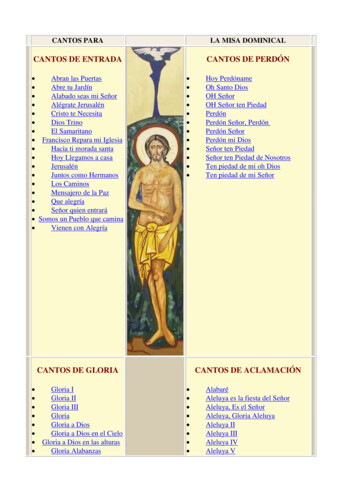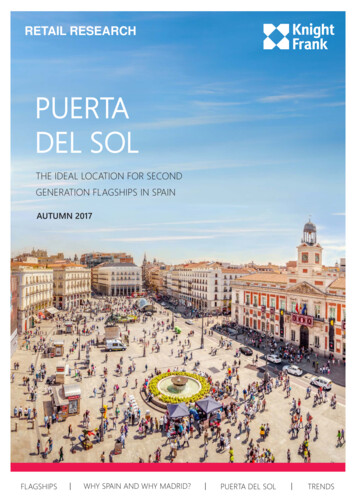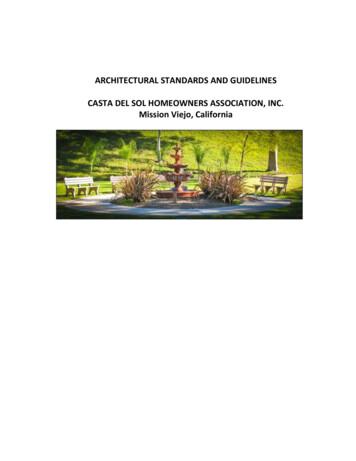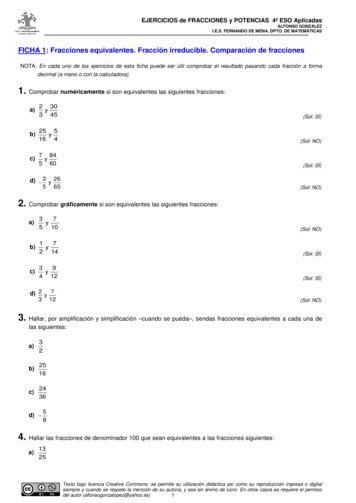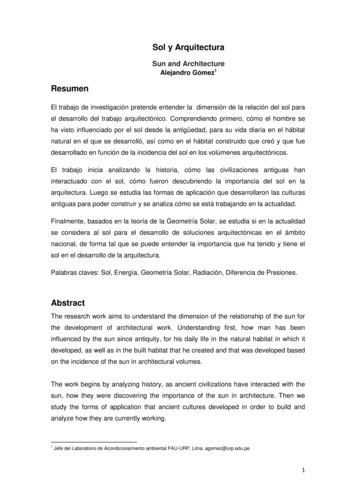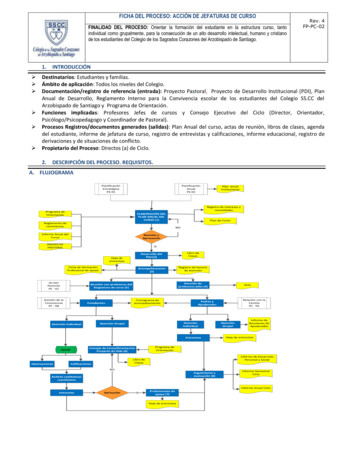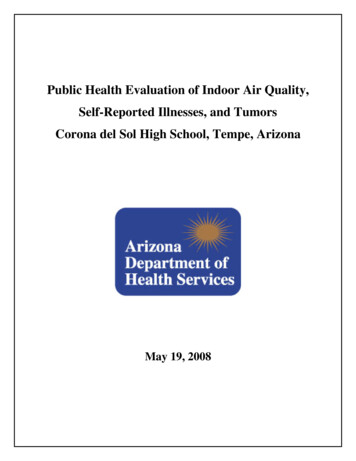
Transcription
Public Health Evaluation of Indoor Air Quality,Self-Reported Illnesses, and TumorsCorona del Sol High School, Tempe, ArizonaMay 19, 2008
1.0OverviewThe Superintendent of Tempe Union High School District (TUHSD), Mr. Steve Adolph,contacted the Arizona Cancer Registry (ACR) on March 4, 2008. Mr. Adolph asked forassistance in addressing a health concern. He explained that there is a perceived excess of braintumors among students and staff at Corona del Sol with approximately eight (8) to twelve (12)brain tumors noted in the last few years. The concerns about tumors arose in conjunction withconcerns about air quality.The air quality concerns include stagnant air, excess carbon dioxide (CO2), wet and moldycarpets around drinking fountains, and other ventilation system problems. These air qualityconcerns were evaluated by industrial hygienists under contract with the school district and thereport is currently available on the TUHSD website. 1The ADHS agreed to review cancer case reports and basic information about the affectedindividuals. This included an analysis of inquiry forms that staff or parents could complete andreturn to the ACR. The ACR reviewed the returned inquiry forms to verify whether the reportedtumors are benign or malignant, and analyzed various other aspects such as patient’s age, gender,and type of cancer.The ADHS also agreed to review the indoor air quality data, make additional recommendationsto improve air quality, and to determine whether the indoor air quality problems identified in thereport may be responsible for adverse health effects.2.0Health Assessment of Reported Conditions2.1BackgroundIn response to the school’s request for an assessment of the tumors, the ACR offered to reviewcase reports, and requested that the school send us basic information about the affectedindividuals. To expedite the process, the ACR e-mailed an inquiry form (Attachment 1) to theschool that the teachers or parents could complete and return to the ACR. The ACR agreed toreview these returned inquiry forms to verify whether the reported tumors are benign ormalignant, and to analyze various other aspects such as patient’s age, gender, and type of cancer.Of note, the school subsequently offered the inquiry form to a broader audience than the cases ofinitial concern. The school made the inquiry form widely available on their website to personswishing to submit a report to the ACR. In addition, there have been public meetings sponsoredby the school at which parents and staff attended and raised health concerns. The situation at theschool has been well publicized in both the broadcast and print media.2.2Arizona Cancer RegistryThe ACR is a program of the Arizona Department of Health Services (ADHS). The ACR is apopulation-based cancer registry for the State of Arizona that began in 1980 as a voluntary1TUHSD Website: https://www.tuhsd.k12.az.us/view.php?page 5&tuhsdgroup 1-2-
hospital-reporting program. The statute 2 was amended and mandated the reporting of cancercases. The statute directs ADHS to operate a statewide cancer registry to monitor patterns ofdisease, identify high-risk groups, and provide data for use by researchers. The state statute doesnot provide specific authority or resources for the registry to conduct cancer investigations orconduct cancer research. Through administrative rule 3 the ACR specifies how hospitals, clinics,and physicians report to the ACR the approximate twenty-four thousand (24,000) new casesdiagnosed in Arizona every year.By law, most cancers (i.e. malignant tumors) diagnosed in Arizona since 1992 are reported to theACR. However, the rules that specify the reportability of tumors exclude most benign tumors.Brain and central nervous system tumors are the only benign tumors that are reportable to theregistry because of their potential for causing significant health effects. There are two primarycategories of primary brain tumors; non-cancerous (benign) and malignant (invasive). Benigntumors harm the brain tissue mainly by causing pressure within the cranial space. Malignanttumors may invade and destroy surrounding brain tissue.Complete data is available on all new cancer cases diagnosed among Arizona residents since1995 through 2004 and includes information on age, race, ethnicity, residence at diagnosis,gender, and specific types of cancer. The ACR adheres to national guidelines for operation ofcentral cancer registries including how cases are defined and coded. The ACR also participatesin the Centers for Disease Control and Prevention National Program of Cancer Registries.2.3MethodsResponse forms submitted to the school or directly to ADHS by April 15, 2008 are available foranalysis. The ACR received one hundred forty-three (143) responses to the inquiry report formgiven to the school district. The responders describe a wide variety of illnesses ranging fromcolds and allergies to cancer. Illnesses with no relationship to cancer or tumors account forseventy-one (71) case reports. The other seventy-two (72) cases were reviewed in detail toidentify those that meet the criteria for inclusion into the ACR database.The criteria for inclusion are an Arizona resident classified with: 1) an invasive or in situ cancer;or 2) a benign tumor of the brain or central nervous system. The review of the seventy-two (72)reports resulted in thirty-eight (38) reports classified as reportable cancer cases. The ACR wantsto ensure that the cases noted among Corona del Sol are recorded in the ACR database to ensurecomplete reporting and verification of cases for the purpose of this report.The identification of reportable cancer cases (n 38) included a review and verification in theACR database. The ACR staff reviewed hospital discharge data to look for cases not found in theACR database to further confirm the information provided on the inquiry report forms. Theinquiry report forms ask where the person was diagnosed. The ACR was able to use the hospitaldischarge data to verify the information. When a facility treating the case was identified throughthe hospital discharge data only, the cancer registrar for that facility was contacted and asked toreview the medical record. If the case met the criteria for case ascertainment a case report was23ARS § 36-133: na Administrative Code: http://www.azsos.gov/aar/2006/3/final.pdf-3-
completed and returned to the ACR. The case was reviewed and quality controlled by the ACRstaff and entered into the ACR database. There are four (4) inquiry report forms that were notverified through the ACR database or the hospital discharge data but listed a physician on theinquiry report form. Physicians identified on the inquiry report forms were contacted and askedto complete a cancer case report form within two days. The ACR received two (2) of the four (4)cases. Two (2) people with two primary cancers are counted as four (4) cases. The thirty-eight(38) reportable cases are classified by site and histology (benign-uncertain vs. in situ-malignant).2.4FindingsThe ACR received one hundred forty-three (143) responses to the inquiry report form sent toTUHSD for identification of cancer cases at Corona del Sol High School. The ACR found thatseventy-one (71) inquiry report forms are of illnesses not related to cancer (See Table 1) andseventy-two (72) inquiry report forms appear to be cancer related and needed further review (SeeTable 2).Statewide, the ACR recorded 7,148 benign and invasive brain and CNS tumors between 1995and 2004 for Arizona residents. The number of brain tumors has risen from 555 in 1995 to 987 in2004. For ACR analysis purposes, primary brain and CNS tumors include the brain, centralnervous system, and brain membranes (meninges).Although not requested, seventy-one respondents submitted annotated forms with conditions notrelated to tumors. These 71 persons self-reported a variety of symptoms including headache (43reports), fatigue (23), sinus infection (14), asthma (12), and various other conditions (60 reports).A person may have had more than one condition. Table 1 summarizes these findings.The inquiry report forms returned to the ACR identified seventy-two (72) tumors or cancers.The majority of these cases were diagnosed between 2004 and 2008. The earliest diagnosis yearis 1988 and the latest diagnosis year is 2008. There are forty (40) female and thirty-two (32)male cases reported and most cases (n 43) are reported among young adults fifteen to twentynine (15-29) years of age. The majority of the cases are students or former students (n 49). SeeGraphs 1-4. Smoking status was also assessed. The majority of respondents do not smoke(n 53), few are former smokers (n 8), one is a current smoker, and ten (10) did not specify theirsmoking status.As shown on Table 2, the ACR review of the seventy-two (72) inquiry forms that mentionedtumors found that thirty-eight (38) cases fit the criteria as a reportable case, twenty-nine (29)cases do not meet the criteria for reporting and five (5) cases cannot be classified as to theirreportable status because not enough information was given on the inquiry report form. Table 3shows the subset of cases that the registry would consider reportable cases. For the remainder ofthe analysis we refer to the seventy-two (72) reports shown in Table 2.The ACR received relatively fewer case reports for all other tumor sites such as breast (n 4),colorectal (n 3), and lung (n 1). Since the primary concern among this community is braintumors and brain cancers the ACR focuses this report on the findings for benign brain andmalignant brain cancers of the seventy-two (72) inquiry report forms with a mention of cancer ortumors, which includes two (2) reports from out of state residents.-4-
A total of eight (8) inquiry report forms identified benign brain tumors and include two casesdiagnosed from students who resided outside Arizona when diagnosed with a brain tumor.These cases were diagnosed between 1990 through 2007 with the majority of cases diagnosedafter 2004. There are five (5) female cases and three (3) male cases. The benign brain tumorswere diagnosed among fifteen to fifty-nine (15-59) year olds. The majority of the cases arecurrent or former students (n 5). See Graphs 5-8. The histologies (cell type) of the reportedbenign brains tumors include hemangioblastoma (n 2), meningioma (n 3), ganglioma (n 1),neurilemmoma (n 1), and pituitary prolactinoma (n 1). The majority of respondents do notsmoke (n 7) and one is a former smoker.A total of five (5) case reports identified malignant brain tumors. These cases were diagnosedbetween 1999 through 2008 with the majority of cases diagnosed in 2006 and later. There arethree (3) female cases and two (2) male cases. The malignant brain tumors were diagnosedamong young adults between the ages of fifteen to twenty-nine (15-29) years of age. All thecases are current or former students (n 5). See Graphs 9-12. The histologies (cell type) of themalignant brain include astrocytoma (n 1), glioblastoma (n 1), glioma (n 1), neuroblastoma(n 1), and pilocytic astrocytoma (n 1). All of the respondents do not smoke (n 5).2.5Rate AssessmentA cancer rate was not calculated for this analysis because the ACR determined a rate calculationis not appropriate given the method of data collection, a non-quantifiable, indeterminatepopulation at risk, and a lack of a geographic area of analysis.2.6Review PanelA review panel met on May, 6, 2008 to discuss the findings of this health assessment. Thefollowing people were in attendance: Dr. Douglas Campos Outcalt (University of ArizonaCollege of Medicine, Phoenix Campus), Dr. Stephen Coons (Barrow’s Neurological Institute),Dr. Timothy Flood (ADHS, Medical Director, Public Health Statistics), Jennifer Botsford(ADHS, Office of Environmental Health), Mary Wolf-Francis (Corona del Sol, ParentCoalition), Ken Komatsu (ADHS, State Epidemiologist), Christopher Newton (ADHS, CancerEpidemiologist), Richard Porter (ADHS, Bureau Chief, Public Health Statistics), Veronica M.Vensor (ADHS, Cancer Data Section Manager), Georgia Yee (ADHS, Office Chief, Office ofHealth Registries), Don Herrington (ADHS, Bureau of Epidemiology and Disease Control), WillHumble (ADHS, Assistant Director, Public Health Preparedness), Susan Edwards (Corona delSol, Principal), Michael Murphy (ADHS, Communications Director), and Janey Pearl (ADHS,Public Information Officer). The data findings were presented to the panel for review anddiscussion. See Flowchart 1.Dr. Coons provided information on the brain cancers. The panel learned that the histologies (celltypes) for the benign tumors reported to the ACR are unrelated and should be considereddifferent diseases. He noted that four of the five malignant brain histologies are considered asarising from one (glial) cell lineage. For the reasons described above, the panel did not feel thatcalculation of rates of either benign or malignant brain tumors was indicated. Radiation is the-5-
only known risk factor for benign brain tumors, but as stated earlier the most common form ofradiation exposure occurs when radiation was given for treatment of leukemia.Dr. Douglas Campos Outcalt identified the limitations to this assessment. The panel agreed thatthe method used to collect cases was biased. It was less likely that earlier students had theopportunity to return the inquiry report form therefore the potential of missed cases exists.Consequently, the findings do show a lack of cases for diagnosis years prior to 2004.Ms. Susan Edwards, Principal at Corona del Sol, informed the review panel that the school wasconstructed approximately 32 years ago, and currently has an enrollment of approximately 2,750students and 200 staff. Ms. Edwards communicated that the safety of her students and staff is ofprimary importance.Ms. Mary Wolf-Francis, Corona del Sol Parent Coalition, expressed concerns of high CO2 andmold found in the school. The Parent Coalition would like to see a full environmental assessmentof the school building.Ms. Jennifer Botsford, ADHS Office of Environmental Health, provided a summary of thefindings from the environmental study conducted by the Health Effects Group.Ms. Veronica M. Vensor and Mr. Christopher Newton, Arizona Cancer Registry, provided asummary of the data findings.2.7DiscussionThis analysis responds to the concerns expressed by staff, parents, and students at Corona del SolHigh School on the perceived excess of brain tumors. These concerns arose in conjunction withconcerns over air quality in the school. The ACR agreed to do an assessment of the cancers,specifically brain. Given this information, the ACR expected to receive most, if not all, casereports for brain tumors or cancers and fewer than expected reports on other cancers. The ACRresponse is limited in this assessment to the cases submitted by the Corona del Sol communityand verified in the existing registry system. Incidence rates of cancer were not calculated,therefore comparisons of rates are unavailable. Nonetheless, although the Corona del Sol casecounts are relatively small in this assessment, we can compare the proportional distribution ofthe Corona del Sol gliomas to the proportion reported nationally by the Central Brain TumorRegistry of the United States (CBTRUS). 4 The CBTRUS reports that gliomas comprise 36% ofall tumors, and 81% of malignant tumors. These proportions are similar to those reported fromCorona del Sol: 4 gliomas among the 13 (30.7%) brain tumor cases and 4 gliomas among the 5(80%) malignant cases.Few risk factors associated with brain cancer are known, 5 and most cases in the U.S. have nolink to these factors. One recognized, environmental risk factor for brain cancer is exposure to4In their latest draft report, the CBTRUS analyses 73,583 tumors diagnosed between 2000 and 2004 from 19participating state registries. The Arizona Cancer Registry is one of the contributing states. In this paragraph weutilize the case definitions of CBTRUS.5Preston-Martin S, Munir R, and Chakrabarti I. Chapter 62: “Nervous System.” pp. 1173-1195. in Shottenfeld Dand Fraumeni JF: Cancer Epidemiology and Prevention, 3rd ed., 2006. Oxford Press.-6-
ionizing radiation. The most common example of radiation induced brain cancer occurs among asmall proportion of patients who received radiation treatment to the brain as part of theirtreatment for leukemia. Other, less recognized, environmental factors with weaker statisticalevidence are exposure in occupational settings to pesticides, vinyl chloride, and petroleumproducts. Some studies have shown an increased risk of brain cancers and other studies havenot. Studies in animals have associated brain cancer with a number of substances, includinglead. 6 Recent human studies did not find an association with increased risk of brain cancer forexposure to aspartame (sugar substitute), electromagnetic fields from cell phones, or hightension wires. Most researchers agree that convincing evidence is not there. Persons withimpaired immune systems are at an increased risk of developing lymphomas of the brain orspinal cord. Also, rare cases of brain cancer run in families. Some of these families have wellknown disorders such as neurofibromatosis type 2, tuberous sclerosis, and von Hippel-Lindausyndrome. General information about the causes of cancer can be found on the website of theNational Cancer Institute. 7Clinicians and epidemiologists from the infectious disease unit of ADHS reviewed the 71 nontumor reports, summarized on Table 1. They were unable to conclude a common infectiousetiology for the reported symptoms. Some reports of asthma symptoms may be indicative ofcases not under optimal clinical control.There were several limitations for this assessment. There was a biased ascertainment of tumorcases. There may be additional cases not currently known to the ACR; it is very likely thatstudents attending the school in its early years did not have the opportunity to complete andreturn the inquiry report form. The number of cancers reported per diagnosis year is small,especially cancers diagnosed in earlier years. The small number of cases per year may result inhighly variable and statistically unstable rates of cancers. This contributed to the ACR’sdecision to not calculate a rate. Additionally, other exposures outside the school cannot beassessed. The low proportion of current smokers (only one of 53 respondents) is significantlydifferent than the state’s smoking rate of 18.2%, implying that the characteristics of respondentsmay be different from that of the general population. Additional factors, such as geneticpredisposition, could not be assessed.2.8SummaryThe review panel and the ACR conclude that a pattern of disease could not be identified, and thatthe tumor and cancer findings are not indicative of a link to environmental factors.3.0Environmental Health Evaluation3.1Purpose & BackgroundThe current of Superintendent of Corona del Sol High School in Tempe, AZ contacted theArizona Department of Health Services (ADHS) and expressed concern about the results ofrecent indoor air studies conducted by Health Effects Group (HEG), Inc. at the school. The67http://ntp.niehs.nih.gov/files/11thROC factsheet ention-genetics-causes-7-
studies suggested that the air exchange and indoor air quality at the school was substandard. Inaddition, some students and staff have complained that they sometimes experience adversehealth effects when they are at the school.The ADHS agreed to review the indoor air quality data, make additional recommendations toimprove air quality, and to determine whether the indoor air quality problems identified in thereport may be responsible for adverse health effects.3.2MethodsThe ADHS examined the analytical results found by HEG and the health effect survey reportsthat were submitted to the Department to determine whether the indoor air quality problemsidentified in the report may be responsible for adverse health effects.The ADHS reviewed the U.S. Environmental Protection Agency’s Tools for Schools programrecommendations to identify potential action items for the school to take that could improveindoor air quality.3.3Data SourcesThis Assessment uses data collected by the Health Effects Group (HEG) during initialassessments of Corona del Sol High School on September 15, 21, and 25, 2006, and February 12and 26, and March 14, 2007. In addition, the report uses information collected from the healtheffects survey reports submitted to the Department by students and staff.Assessments conducted by HEG included: a visual inspection of classrooms and common areaswithin the school, the collection of microbial air samples in selected classrooms and commonareas, monitoring general indoor air quality parameters in selected classrooms and commonareas, the collection and analysis of swab and dust samples for microbial agents at selectedcarpeted locations, a review of general chemical use at the school, the collection of indoor airsamples to look for viable and non-viable fungal spores, and the collection and analysis of 2outdoor air samples for comparison purposes.Indoor air quality parameters were measured with a TSI Incorporated Indoor Air Quality MeterModel 8762. Indoor air quality parameters measured are listed in Table 1. The contractorsampled for microbials in the following methods: air sampling, swab sampling, and Carpet dustsampling. The microbials that were identified are listed in Table 1.No environmental samples (i.e., air, water or soil samples) were collected for chemical analysis.However, the contractor did discuss the use of chemicals with the school. The contractorreviewed the MSDS sheets that were stored on site and visually inspected the chemicals stored orused at the school. The list of chemicals is in Table 1.-8-
Table 1 Sampling/InvestigationIndoor Air QualityParametersCarbon Dioxide (CO2)Carbon Monoxide (CO)HumidityTemperatureIdentified MicrobialsAir SamplingMold:Acremonium, Alternaria, Ascospores, Aspergillus flavus,Aspergillus niger, Aspergillus sydowii, Aspergillus ustus,Aspergillus versicolor, Aspergillus – other, Basidiospores,Bipolaris/Dreschlera group, Chaetomium, Cladosporium,Culvularia, Epicoccum, Non-sporulating fungi, Other Brown,Paecilomyces, Penicillium, Phoma/coelomycetes, Rhizopus,Smuts & Myxomycetes, Torula, and UlocladiumMold:Acremonium, Aspergillus niger, Aspergillus ustus, Aspergillusversicolor, Exophiala, Fusarium, Penicillium, and yeastsSwab samplingBacteria:Broad spectrum bacteria, gram negative coliform, gram negativenon-fermentative, and gram positiveCarpet dust samplingChemicalsMold:Alternaria, Aspergillus caespitosus, Aspergillus flavus,Aspergillus fumigatus, Aspergillus niger, Aspergillus ochraceus,Aspergillus sydowii, Aspergillus terreus, Aspergillus ra,Chrysonilia, Cladosporium, Epicoccum, Fusarium, Humicola,Peniscillium, Phoma/coelomycetes, Rhizopus, Ulocladium, andyeastsMSDS sheets found for:ethanolamine, glycol ethers, quaternary ammonium compounds,and hydrocarbon-based solventsChemicals found on site by contractor:Tetrachloroethylene, formalin-9-
3.4Results3.4.1Indoor Air Quality ResultsCarbon DioxideCarbon Dioxide (CO2) is a naturally present in the atmosphere at levels of approximately 350parts per million or ppm (0.035%). Higher outdoor CO2 concentrations can be found near vehicletraffic area, industry and sources of combustion. People exhale CO2 – the average adult’s breathcontains about 35,000 to 50,000 ppm of CO2. Hence, CO2 buildup is used as an indicator ofpoorly ventilated areas characterized by inadequate fresh air or inadequate air supply inbuildings.The current occupational safety standard is 5,000 ppm for healthy adults for an 8-hour work daywithin a 40-hour workweek. While levels below 5,000 ppm are considered to pose no serioushealth impacts, experience indicates that individuals in schools and offices with CO2concentrations greater than 1,000 ppm tend to report drowsiness, lethargy, and a general sense ofstale air. According to the American Society of Heating, Refrigeration, and Air ConditioningEngineers (ASHRAE), classrooms should maintain CO2 concentrations below 1,000 ppm inorder to maximize comfort. Maintaining less than 1,000 ppm of CO2, usually requires that 15cubic feet per minute (CFM) of outside air per person be introduced through the ventilationsystem.The average CO2 concentrations found at Corona del Sol were between 1,140 ppm and 1,960ppm in the morning and in the afternoon, respectively. Nearly all samples exceeded ASHRAE’srecommendation of 1,000 ppm. These results suggest that improving classroom ventilationwould improve student and staff comfort.Carbon MonoxideCarbon monoxide (CO) is a potentially deadly gas. It is colorless, odorless, tasteless and nonirritating. CO, produced by the combustion of petroleum, is commonly present in ambient air atlow levels. The most common sources of indoor carbon monoxide are motor vehicle emissionsand stationary sources, such as furnaces and water and space heaters.The adverse health effects associated with CO vary with its concentration and duration ofexposure. Clinical symptoms range from subtle cardiovascular, respiratory, and neurobehavioraleffects at low concentrations (10 ppm) to unconsciousness and death after prolonged exposuresor after acute exposure to high concentration of CO ( 500ppm). The World Health Organization(WHO) recommends that indoor air levels for CO to be kept below an average of 9 ppm for any8-hour period and below 35 ppm for any 1-hour period.The measured CO concentrations ranged from 1.6 to 2.3 ppm with an average of 2.1 ppm at thesampling locations. Levels of CO measured during the investigation are below WHO’srecommendation, and CO does not appear to represent a health threat at the school.- 10 -
3.4.2 Microbial Analytical ResultsWater leaks and humidity provide the moisture needed for microbial growth. Molds can be foundalmost anywhere; they can grow on virtually any substance, providing moisture is present. Thereare molds that can grow on wood, paper, carpet, and foods. There is no practical way toeliminate all mold and mold spores in the indoor environment; the way to control indoor moldgrowth is to control moisture.Inhalation of mold spores can cause the following acute (short term) health effects: allergicreactions, asthma, and other respiratory complaints. Some people are sensitive to molds. Forthese people, exposure to molds can cause symptoms such as nasal stuffiness, eye irritation,wheezing, or skin irritation. Some people, such as those with serious allergies to molds, mayhave more severe reactions. Severe reactions may occur among workers exposed to largeamounts of molds in occupational settings, such as farmers working around moldy hay. Severereactions may include fever and shortness of breath.A number of different mold species in varying concentrations have been identified in samplescollected by HEG. In general, the species and concentrations of mold and mold spores that werefound indoors at the school were similar to the species and concentrations found outdoors.However, because of the limited number of samples that were collected outdoors it is difficult todraw conclusions regarding whether there are still sources of gross mold contamination at theschool.There is a wide range of susceptibility to allergic reactions to molds, and some students and staffmay be exposed to levels of mold and mold spores that could potentially result in allergicresponses among students and staff. However, there are currently insufficient data to concludewhether or not any symptoms that persons may be experiencing are a result of exposure to indoormold sources at the school.4.0ConclusionsThe indoor carbon dioxide levels found at Corona del Sol High School were higher than therecommended maximum of 1,000 parts per million. These results suggest that the carbon dioxidethat accumulates during the school day could be causing drowsiness, lethargy, and a sense of“stale air” among students and staff. There is currently insufficient information to concludewhether or not the symptoms that people have been experiencing are due to indoor mold.Exposures or potential exposures did not fit recognized risk factors for brain tumors. The ReviewPanel was unable to establish a link between brain tumors and environmental factors at Coronadel Sol High School.- 11 -
5.0Recommendations Adjust or modify the ventilation system to ensure that carbon dioxide concentrations aremaintained below 1,000 parts per million to reduce drowsiness, lethargy, and a sense of“stale air” among students and staff. Consider using mobile carbon dioxide monitors inclassrooms and offices to ensure that CO2 levels are maintained below 1000 ppm. Because mold and mold spores can cause allergic responses and aggravate asthma andother respiratory conditions, gross (visible) mold and mold spore contamination shouldbe eliminated. Following the completion of mold removal activities, conductsimultaneous indoor and outdoor airborne mold tests to ensure that the major sources ofindoor mold have been eliminated. Consider replacing carpets with nonabsorbent materials such as tile in high-traffic andmoisture prone areas. Carpeting has a much larger surface area than tile and canaccumulate allergens that cause indoor air quality problems. Review and implement the Environmental Protection Agency’s Tools for Schoolsenvironmental assessment program to improve the school’s indoor air - 12 -
ReferencesAgency for Toxic Substances and Disease Registry. Toxicological Profile for IonizingRadiation. September 1999. US Department of Health and Human Services, Atlanta GA.Agency for Toxic Substances and Disease Registry. Toxicological Profile for Acrylonitr
The Superintendent of Tempe Union High School District (TUHSD), Mr. Steve Adolph, contacted the Arizona Cancer Registry (ACR) on March 4, 2008. Mr. Adolph asked for . case reports, and requested that the school send us basic information about the affected individuals. To expedite the process, the ACR e-mailed an inquiry form (Attachment 1) to the



